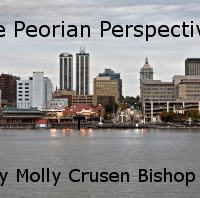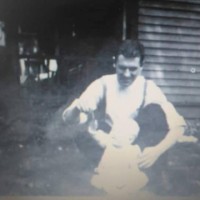Molly Crusen Bishop: From County Kilkenny, Ireland to Peoria
Below is the Peoria Star Monday May 7th, 1923 obituary for my Great Aunt Maggie
Mrs. Margaret Nolan Caffyn
“On the hillside in old St. Mary’s cemetery there is a little mound of freshly turned clay, entirely covered with the most beautiful flowers of springtime, beneath which were laid with loving hands this morning all that was mortal of Mrs. Margaret Nolan Caffyn, 905 Smith Street, widow of the late Jacob Caffyn, and who died in this city last Saturday morning.
Maggie Nolan, which was her maiden name, was the last surviving member of a party of young Irish folks who came to Peoria from County Kilkenny in the late 1860s , and gave the best they had to the up-building of this community until each in turn was summoned unto rest.
From this little group of Irish pioneers there has sprung an ever-widening circle of descendants and friends, so that when they were gathered in St. Patrick’s church this morning to pay the last tribute of respect that large edifice was very well filled with the decedent’s relatives and friends, who united with the officiating priest, Rev. Fr. Cullerton, in sending her soul beyond the skies on a wave of prayer and sacred melody.
At the time of her death Mrs. Caffyn was 76 years of age, and leaves to mourn her loss, besides relatives and friends mentioned, her sister Miss Joanna Nolan, and members of her husband’s family.”
Maggie Nolan was my great grandmother’s sister. My great grandmother was named Kate Nolan Waugh. There were two other sisters named Johanna and Mary, and a brother named James. All five of the siblings were a part of this group of young Irish folks that came from County Kilkenny.
Next is the brief obituary from 1920 of my great-great uncle, Thaddeus McGowan. This comes from a copy and it doesn’t say which newspaper.
“Thaddeus McGowan was aged 90 years and a resident of Peoria for 20 years, died suddenly of a complication of ailments at 11 0’clock last night at the home of his nephew Charles Needham at 113 Barker Avenue.
Mr. McGowan was born in Egypt County, Ireland, in 1830, and came to America in 1865. He settled in Brooklyn, New York, where he followed the builder’s trade. Twenty years ago he came to Peoria to live with his sister, 24 years his younger, Mrs. Ellen McGowan Needham. On Ellen Mary McGowan Needham’s death certificate it lists that she was born in May, 1854 to Patrick McGowan and Ellen Mulligan McGowan. Thaddeus’s information lists him as a widower born in 1830.
The Needham family lived on the West Bluff, in a humble house on Barker Avenue. There were family stories of an Aunt Jo, or Joanna Nolan, lifting up her skirts and doing the Irish jig and reel, while the Needhams would be listening to records of the Irish jig and hornpipes playing on the family victrola. Thaddeus had built a larger home down the street from the Needham house on Barker, yet he never lived there. The family rented out the home to earn income.
My great-grandma Kate Nolan Waugh died in 1900 in her early 40s, leaving seven children age 14 and younger. I feel I can get to know a bit of the family’s personality through family papers, and their obituaries.
Aunt Jo was quite a character; as I stated she was known to lift her skirts and dance a jig. She was also known to smoke a clay pipe. Her Irish brogue was said to be very thick, and she was very witty, and had a sarcastic yet humorous attitude. She worked as a carpet sewer, and had several finger injuries from doing this as a living. Jo also had a hairpiece that family info says wiggled when she would scratch or shake her head too much.
James Nolan was the brother born in Kilkenny, Ireland and he came to Peoria with his sisters and other young folks when he was only 19 years old. He was a night watchman for the Corning rectifying plant for more than two decades. He was married to Catherine Doherty in 1875 and they lived on Third Avenue. They had four daughters and one son. His obituary lists his sisters as Mrs. Maggie Nolan Caffyn, Mrs. Mary Nolan Kenny, and Miss Johanna Nolan, and the late Kate Nolan Waugh. His funeral was at St. Patrick’s Church. Most of the siblings are buried at St. Mary’s Cemetery on Sterling Avenue in West Peoria.
The Needham, Nolan, and Waugh family’s lives intertwined through marriages, friendships and church. They also had a lot in common with many young Irish immigrants during the middle to late 1800s.
Ireland suffered from the potato famine off and on for decades. This was also known as the “great hunger” and the “great blight” as well. The English controlled much of their lives and had control of their destinies. There were plenty of other crops and food grown during the famine, but the English would have it shipped back to England, leaving many poor tenant farmers without any decent food for sustenance. Many times they were not allowed the right to vote, own land, and at one point a law was passed that an Irishman could be arrested just for walking outside at the wrong time of day, even on the land they lived on.
The entire country was suffering from mass starvation, disease, and emigration. The term Diaspora is often found when reading or researching this topic. Diaspora’s definition is an involuntary mass dispersion of historic proportions forcing people to emigrate from their homeland to other places. There were so many people and children dying, some had green, grass-stained mouths from eating grass, while slowly dying from starvation.
Many starving Irishmen and women sold anything they had to take a chance in America and Canada. They would arrive in Liverpool, England, and take passage in distressing conditions on what was known as “coffin ships.” These coffin ships were old English ships from the late 1700s and early 1800s and were very unsanitary and unsafe. I have read accounts of these ships arriving on the coast of Canada and America, with the Irish crawling upon the shore and dying while trying to get to their destination. Their bodies were weak and frail and malnourished, and they mustered all of their strength, leaving everything they had ever known to come here to die.
Ship conditions improved slightly by the 1860s when my Irish ancestors were coming here, but opportunities for the younger Irish were very small in Ireland, making the dream of American all the more appealing.
If you couldn’t own land, had little to no education, and no job opportunities to feed and support one’s family, it is no wonder that Ireland lost around a million souls to death, and another million who left for Canada and America.
My mom, Joani Needham Crusen, celebrated her Irish heritage. She signed me up for Irish dancing lessons in the early 1980s. I was one of the original modern group of Irish dancers in Peoria, along with Megan Hanigan, the Doyle sisters, Grainne Kenny, and others. Each St. Patrick’s Day we would get to miss school at St. Mark and dance throughout the parade. We would be wearing our kilts and gillies and venture over to perform at the Pere Marquette, followed by a performance at the Holiday Inn, usually a nursing home or two.
The finale of the day was dancing at the Donnelly family Shamrock Pub event at Expo Gardens. We often danced at the early Erin Feis celebrations, at many schools’ cultural week events, etc.
I am now 45 and I can still do five steps of the Irish jig and most of a reel or two. I try to continue to learn as much as I can about my ancestry, and the Irish chapter is filled with controversy, pain and suffering, yet the strength of the spirit of an Irishman is bigger than these. The joy, the ability to be a storyteller, the energy and love of the ancient dance, and the ability of their sheer strength, heart, mind, and bodies to survive in catastrophic conditions outweighs the darkness. There is nothing quite like the twinkle in the eyes of the Irish, nor like the contagious laughter that comes from deep within their soul, or the wit from telling a good tale.
It comes to my heart how much my ancestors’ stories are so adaptable to the world we are living in today.
I am personally so thankful for the bravery and strength of these humble Irish ancestors. There is an expression by Linda Hogan that sums up my love for my ancestors, “Walking, I am listening to a deeper way. Suddenly all my ancestors are behind me. Be still, they say. Watch and listen for you are the result of a thousand loves.”


